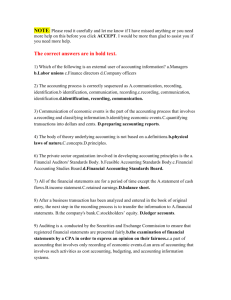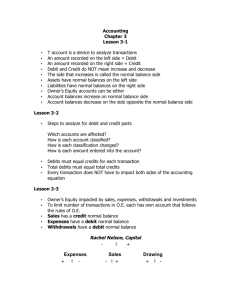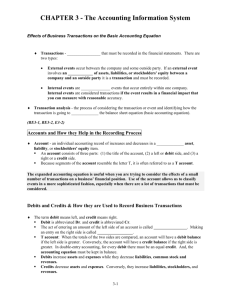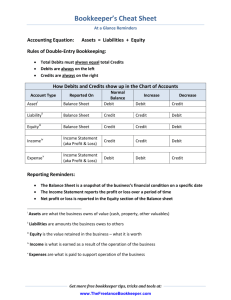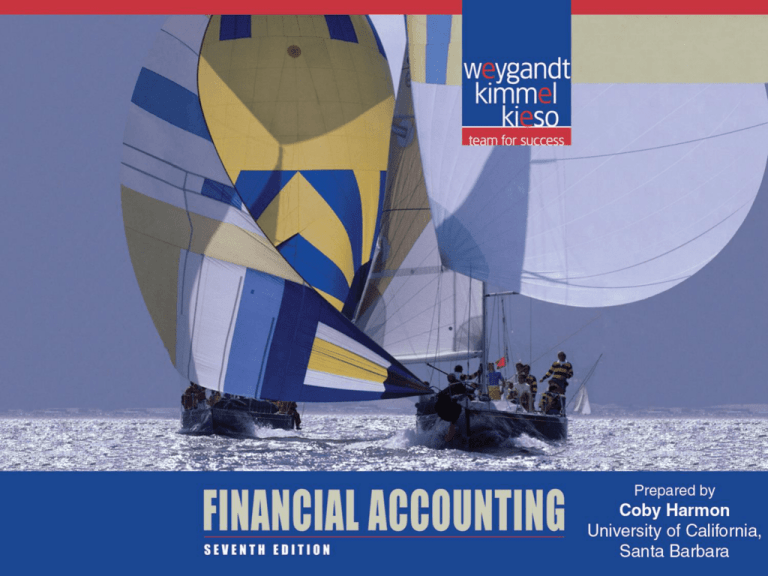
Slide
2-1
Chapter
2
The Recording
Process
Financial Accounting,
Seventh Edition
Slide
2-2
Study Objectives
Slide
2-3
1.
Explain what an account is and how it helps in the
recording process.
2.
Define debits and credits and explain their use in
recording business transactions.
3.
Identify the basic steps in the recording process.
4.
Explain what a journal is and how it helps in the
recording process.
5.
Explain what a ledger is and how it helps in the recording
process.
6.
Explain what posting is and how it helps in the recording
process.
7.
Prepare a trial balance and explain its purposes.
The Recording Process
The Account
Debits and
credits
Debit and credit
procedure
Stockholders’
equity
relationships
Summary of
debit/credit
rules
Slide
2-4
Steps in the
Recording
Process
Journal
Ledger
Posting
The Recording
Process
Illustrated
Summary
illustration of
journalizing and
posting
The Trial Balance
Limitations of a
trial balance
Locating errors
Use of dollar
signs
The Account
Account
Record of increases and decreases
in a specific asset, liability, equity,
revenue, or expense item.
Debit = “Left”
Credit = “Right”
An Account can
be illustrated in a
T-Account form.
Slide
2-5
Account Name
Debit / Dr.
Credit / Cr.
SO 1 Explain what an account is and how it helps in the recording process.
Debits and Credits
Double-entry accounting system
Each transaction must affect two or more
accounts to keep the basic accounting equation
in balance.
Recording done by debiting at least one account
and crediting another.
DEBITS must equal CREDITS.
Slide
2-6
SO 2 Define debits and credits and explain their
use in recording business transactions.
Debits and Credits
If Debits are greater than Credits, the account
will have a debit balance.
Account Name
Debit / Dr.
Transaction #1
$10,000
Transaction #3
8,000
Balance
Slide
2-7
Credit / Cr.
$3,000
Transaction #2
$15,000
SO 2 Define debits and credits and explain their
use in recording business transactions.
Debits and Credits
If Credits are greater than Debits, the account
will have a credit balance.
Account Name
Debit / Dr.
Transaction #1
Balance
Slide
2-8
$10,000
Credit / Cr.
$3,000
Transaction #2
8,000
Transaction #3
$1,000
SO 2 Define debits and credits and explain their
use in recording business transactions.
Debits and Credits Summary
Liabilities
Normal
Balance
Debit
Normal
Balance
Credit
Assets
Credit / Cr.
Normal Balance
Chapter
3-24
Equity
Credit / Cr.
Debit / Dr.
Debit / Dr.
Debit / Dr.
Credit / Cr.
Normal Balance
Normal Balance
Chapter
3-23
Expense
Debit / Dr.
Revenue
Chapter
3-25
Credit / Cr.
Debit / Dr.
Normal Balance
Chapter
3-27
Slide
2-9
Credit / Cr.
Normal Balance
Chapter
3-26
SO 2
Debits and Credits Summary
Balance Sheet
Asset = Liability + Equity
Income Statement
Revenue - Expense
Debit
Credit
Slide
2-10
SO 2 Define debits and credits and explain their
use in recording business transactions.
Debits and Credits Summary
Review Question
Debits:
a. increase both assets and liabilities.
b. decrease both assets and liabilities.
c. increase assets and decrease liabilities.
d. decrease assets and increase liabilities.
Slide
2-11
Solution
notes page
SO 2 Define debits and credits and explain their
use in recording business transactions.
Assets and Liabilities
Assets
Debit / Dr.
Credit / Cr.
Normal Balance
Liabilities – Credits
should exceed debits.
Chapter
3-23
Liabilities
Debit / Dr.
Assets - Debits should
exceed credits.
Credit / Cr.
The normal balance is on
the increase side.
Normal Balance
Chapter
3-24
Slide
2-12
SO 2 Define debits and credits and explain their
use in recording business transactions.
Stockholders’ Equity
Issuance of stock and
revenues increase equity
(credit).
Equity
Debit / Dr.
Credit / Cr.
Dividends and expenses
decrease equity (debit).
Normal Balance
Chapter
3-25
Common Stock
Debit / Dr.
Retained Earnings
Credit / Cr.
Debit / Dr.
Normal Balance
Chapter
3-25
Slide
2-13
Chapter
3-25
Dividends
Credit / Cr.
Debit / Dr.
Normal Balance
Normal Balance
Credit / Cr.
Chapter
3-23
SO 2 Define debits and credits and explain their
use in recording business transactions.
Revenue and Expense
Revenue
Debit / Dr.
Credit / Cr.
Normal Balance
Chapter
3-26
Expense
Debit / Dr.
Normal Balance
The purpose of earning
revenues is to benefit the
owner(s).
The effect of debits and
credits on revenue accounts is
the same as their effect on
Owner’s Capital.
Credit / Cr.
Expenses have the opposite
effect: expenses decrease
owner’s equity.
Chapter
3-27
Slide
2-14
SO 2 Define debits and credits and explain their
use in recording business transactions.
Debits and Credits Summary
Review Question
Accounts that normally have debit balances are:
a. assets, expenses, and revenues.
b. assets, expenses, and retained earnings.
c. assets, liabilities, and dividends declared.
d. assets, dividends declared, and expenses.
Slide
2-15
Solution
notes page
SO 2 Define debits and credits and explain their
use in recording business transactions.
Summary of Debit/Credit Rules
Relationship among the assets, liabilities and
stockholders’ equity of a business:
The equation must be in balance after every transaction.
For every Debit there must be a Credit.
Slide
2-16
SO 2 Define debits and credits and explain their
use in recording business transactions.
Summary of Debit/Credit Rules
Kathy Browne, president of Hair It Is, Inc., has
just rented space in a shopping mall in which she
will open and operate a beauty salon. A friend has advised Kathy to
set up a double-entry set of accounting records in which to record
all of her business transactions. Following are the balance sheet
accounts that Hair It Is, Inc., will likely need to record the
transactions. Indicate whether the normal balance of each account
is a debit or a credit.
Slide
2-17
Cash
Debit
Equipment
Debit
Supplies
Debit
Accounts payable
Credit
Notes payable
Credit
Common stock
Credit
Solution on
notes page
SO 2 Define debits and credits and explain their
use in recording business transactions.
Steps in the Recording Process
Illustration 2-13
Analyze each transaction
Enter transaction in a journal
Transfer journal information
to ledger accounts
Business documents, such as a sales
slip, a check, a bill, or a cash register
tape, provide evidence of the
transaction.
Slide
2-18
SO 3 Identify the basic steps in the recording process.
The Journal
Book of original entry.
Transactions recorded in chronological order.
Contributions to the recording process:
1. Discloses the complete effects of a transaction.
2. Provides a chronological record of transactions.
3. Helps to prevent or locate errors because the debit
and credit amounts can be easily compared.
Slide
2-19
SO 4 Explain what a journal is and how it helps in the recording process.
Journalizing
Journalizing - Entering transaction data in the journal.
Illustration: On September 1, stockholders invested
$15,000 cash in exchange for shares of stock, and Softbyte
purchased computer equipment for $7,000 cash.
Illustration 2-14
General Journal
Date
Sept. 1
Account Title
Cash
Ref.
Debit
15,000
Common stock
Computer equipment
Cash
Slide
2-20
Solution on
notes page
Credit
15,000
7,000
7,000
SO 4
Journalizing
Simple and Compound Entries
Illustration: Assume that on July 1, Butler Company
purchases a delivery truck costing $14,000. It pays $8,000
cash now and agrees to pay the remaining $6,000 on account.
Illustration 2-15
General Journal
Date
Sept. 1
Slide
2-21
Solution on
notes page
Account Title
Delivery equipment
Ref.
Debit
Credit
14,000
Cash
8,000
Accounts payable
6,000
SO 4
The Ledger
A General Ledger contains the entire group of accounts
maintained by a company.
The General Ledger includes all the asset, liability,
stockholders’ equity, revenue and expense accounts.
Illustration 2-16
Slide
2-22
SO 5 Explain what a ledger is and how it helps in the recording process.
Slide
2-23
SO 5 Explain what a ledger is and how it helps in the recording process.
Standard Form of Account
T-account form used in accounting textbooks.
In practice, the account forms used in ledgers are
much more structured.
Illustration 2-17
Slide
2-24
SO 5 Explain what a ledger is and how it helps in the recording process.
Chart of Accounts
Accounts and account numbers arranged in sequence in
which they are presented in the financial statements.
Illustration 2-18
Slide
2-25
SO 5 Explain what a ledger is and how it helps in the recording process.
Posting
Posting – the
process of
transferring
amounts from
the journal to
the ledger
accounts.
Illustration 2-19
Slide
2-26
SO 6 Explain what posting is and how it helps in the recording process.
The Recording Process Illustrated
Follow these steps:
1. Determine what
type of account
is involved.
2. Determine what
items increased
or decreased
and by how
much.
3. Translate the
increases and
decreases into
debits and
credits.
Illustration 2-20
Slide
2-27
SO 6 Explain what posting is and how it helps in the recording process.
The Recording Process Illustrated
Illustration 2-21
Slide
2-28
SO 6 Explain what posting is and how it helps in the recording process.
The Recording Process Illustrated
Illustration 2-22
Slide
2-29
SO 6
The Recording Process Illustrated
Illustration 2-23
Slide
2-30
SO 6
The Recording Process Illustrated
Illustration 2-24
Slide
2-31
SO 6
The Recording Process Illustrated
Illustration 2-25
Slide
2-32
SO 6
The Recording Process Illustrated
Illustration 2-26
Slide
2-33
SO 6 Explain what posting is and how it helps in the recording process.
The Recording Process Illustrated
Illustration 2-27
Slide
2-34
SO 6
The Recording Process Illustrated
Illustration 2-28
Slide
2-35
SO 6
The Recording Process Illustrated
Illustration 2-29
Slide
2-36
SO 6
Posting
Review Question
Posting:
a. normally occurs before journalizing.
b. transfers ledger transaction data to the journal.
c. is an optional step in the recording process.
d. transfers journal entries to ledger accounts.
Solution on
notes page
Slide
2-37
SO 6 Explain what posting is and how it helps in the recording process.
The Recording Process Illustrated
Kate Turner recorded the following transactions
in a general journal during the month of March.
Post these entries to the Cash account.
Slide
2-38
Solution on
notes page
SO 6
The Trial Balance
Illustration 2-32
A list of accounts
and their
balances at a
given time.
Purpose is to
prove that debits
equal credits.
Slide
2-39
SO 7 Prepare a trial balance and explain its purposes.
The Trial Balance
Limitations of a Trial Balance
The trial balance may balance even when
1.
a transaction is not journalized,
2. a correct journal entry is not posted,
3. a journal entry is posted twice,
4. incorrect accounts are used in journalizing or
posting, or
5. offsetting errors are made in recording the amount
of a transaction.
Slide
2-40
SO 7 Prepare a trial balance and explain its purposes.
The Trial Balance
Review Question
A trial balance will not balance if:
a. a correct journal entry is posted twice.
b. the purchase of supplies on account is debited to
Supplies and credited to Cash.
c. a $100 cash drawing by the owner is debited to
Owner’s Drawing for $1,000 and credited to Cash
for $100.
d. a $450 payment on account is debited to Accounts
Payable for $45 and credited to Cash for $45.
Slide
2-41
Solution on
notes page
SO 7 Prepare a trial balance and explain its purposes.
Slide
2-42
SO 7 Prepare a trial balance and explain its purposes.
The Trial Balance
The accounts
come from the
ledger of
Christel
Corporation at
December 31,
2011.
Slide
2-43
Solution on
notes page
SO 7
Your Personal Annual Report
David Edmondson, the president and CEO of well-known
electronics retailer Radio Shack, overstated his
accomplishments by claiming that he had earned a bachelor’s
of science degree, when in fact he had not. Apparently his
employer had not done a background check to ensure the
accuracy of his résumé.
A chief financial officer of Veritas Software lied about having
an M.B.A. from Stanford University.
Slide
2-44
A former president of the U.S. Olympic Committee lied
about having a Ph.D. from Arizona State University. When
the truth was discovered, she resigned.
The University of Notre Dame discovered that its football
coach, George O’Leary, lied about his education and football
history. He was forced to resign after only five days.
Slide
2-45
A survey by Automatic Data Processing reported that 40% of
applicants misrepresented their education or employment
history.
A survey by the
Society for Human
Resource Management
of human resource
professionals
reported the following
responses to the
following question.
Slide
2-46
Using Radio Shack as an example, what should the company have
done when it learned of the falsehoods on Mr. Edmondson’s
résumé? Should Radio Shack have fired him?
NO: Mr. Edmondson had been a Radio Shack employee for 11 years.
He had served the company in a wide variety of positions, and had
earned the position of CEO through exceptional performance. While
the fact that he lied 11 years earlier on his résumé was unfortunate,
his service since then made this past transgression irrelevant. In
addition, the company was in the midst of a massive restructuring,
which included closing 700 of its 7,000 stores. It could not afford
additional upheaval at this time.
YES: Radio Shack is a publicly traded company. Investors,
creditors, employees, and others doing business with the company
will not trust it if its leader is known to have poor integrity. The
Slide “tone at the top” is vital to creating an ethical organization.
2-47
Copyright
Copyright © 2010 John Wiley & Sons, Inc. All rights reserved.
Reproduction or translation of this work beyond that permitted
in Section 117 of the 1976 United States Copyright Act without
the express written permission of the copyright owner is
unlawful. Request for further information should be addressed
to the Permissions Department, John Wiley & Sons, Inc. The
purchaser may make back-up copies for his/her own use only
and not for distribution or resale. The Publisher assumes no
responsibility for errors, omissions, or damages, caused by the
use of these programs or from the use of the information
contained herein.
Slide
2-48


